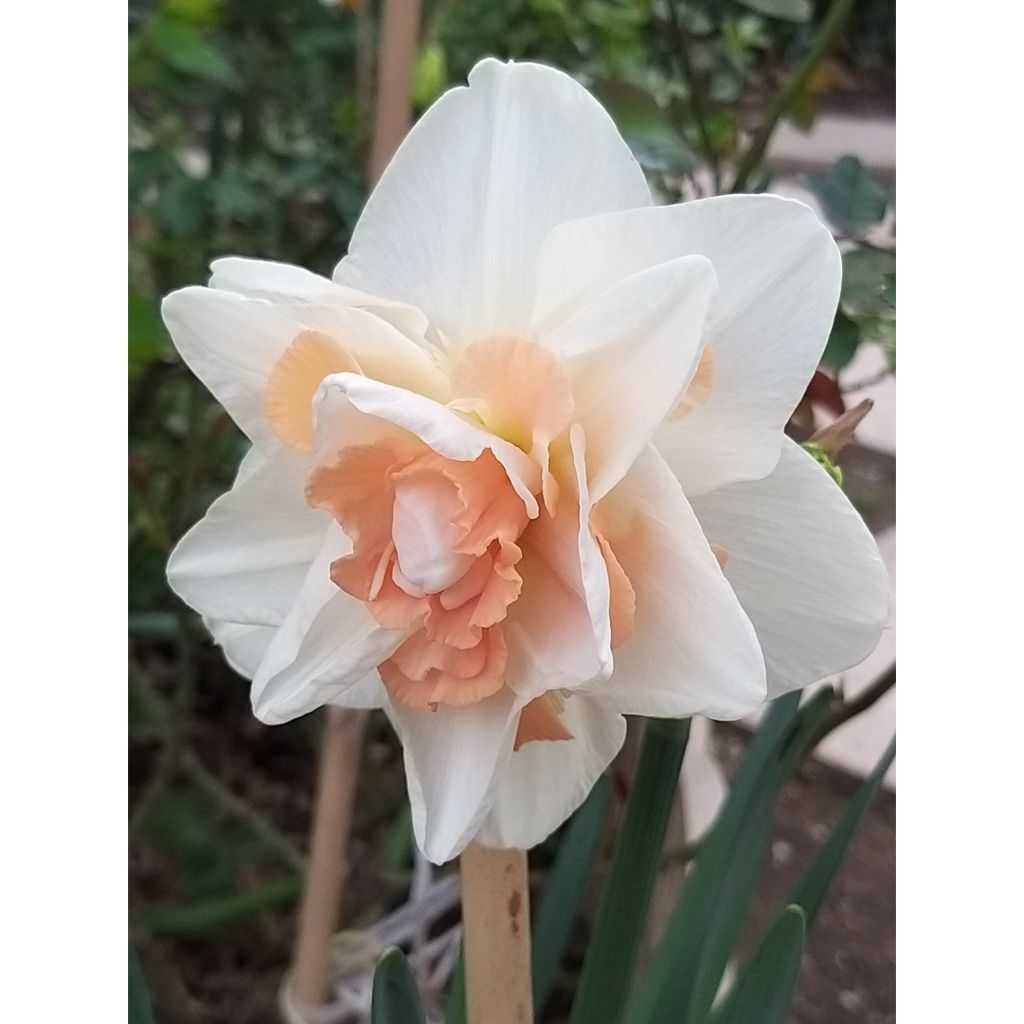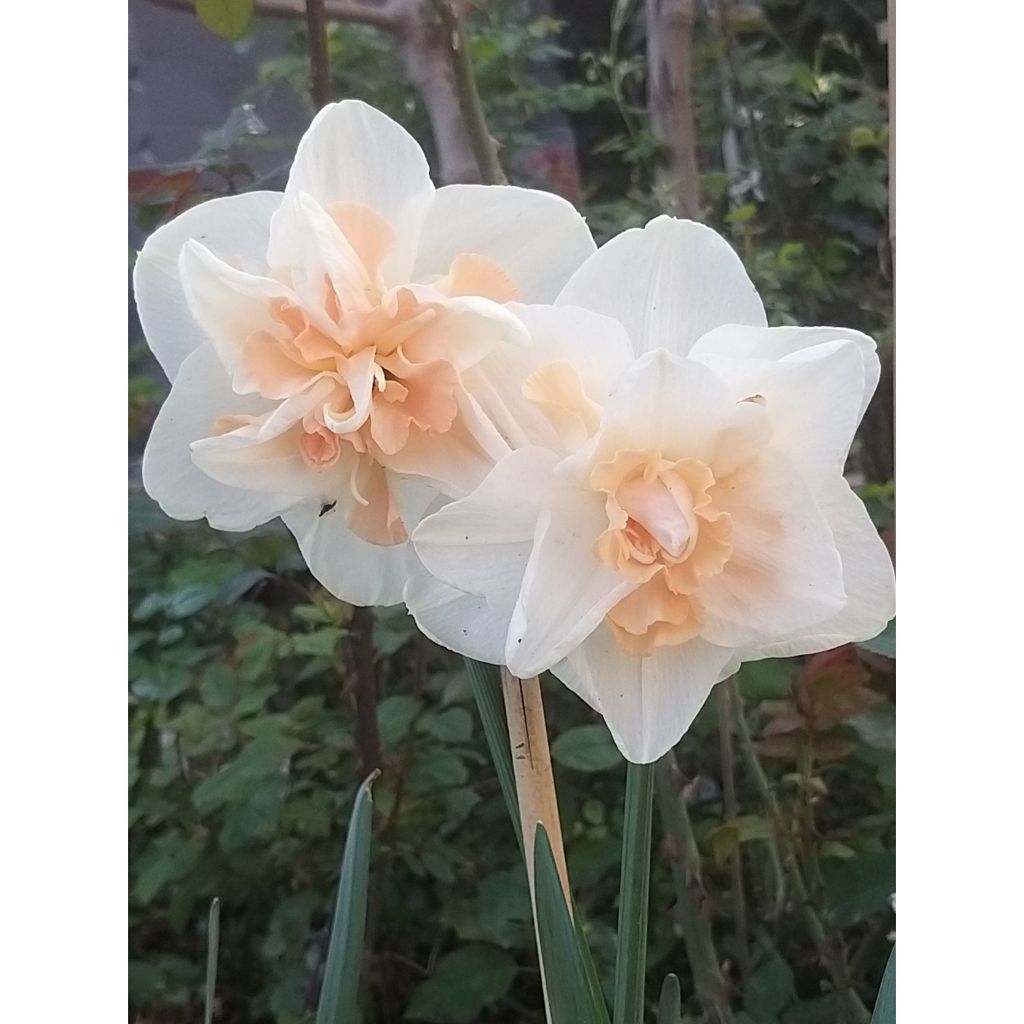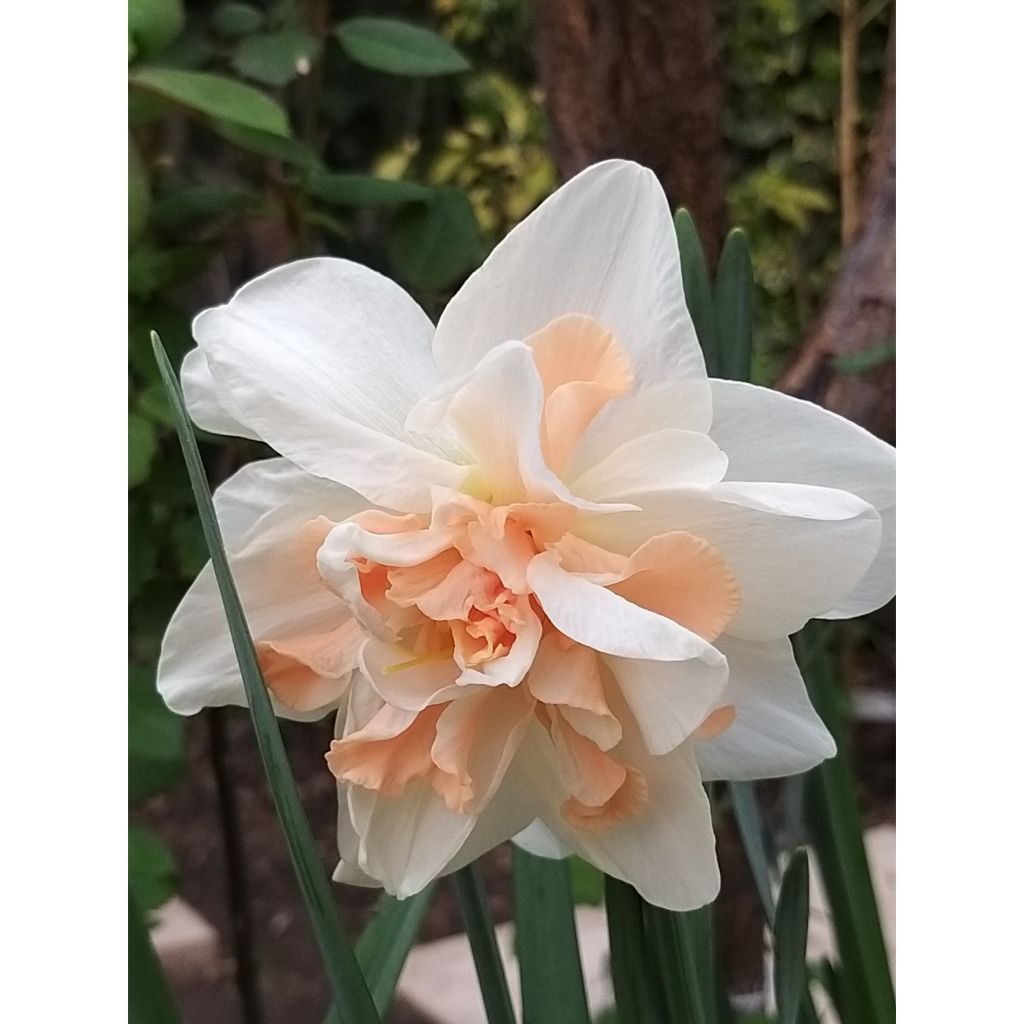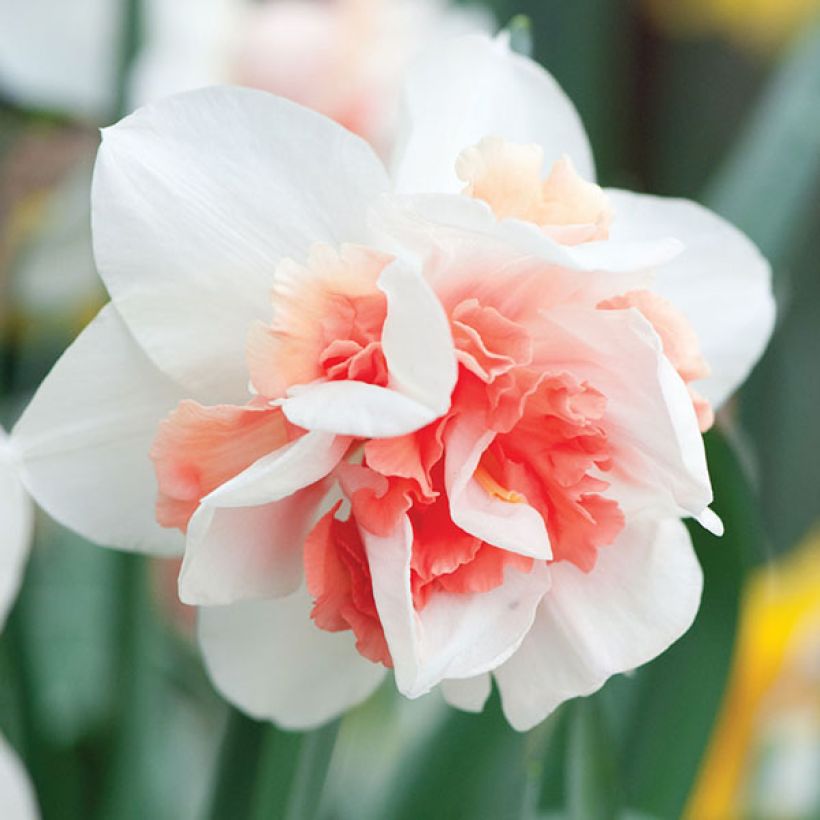

Narcissus Rosy Cloud


Narcissus Rosy Cloud


Narcissus Rosy Cloud
Narcissus Rosy Cloud
Narcissus x odorus Rosy Cloud
Campernelle Jonquil, Campernelle, Large-cupped Daffodil
This plant carries a 6 months recovery warranty
More information
We guarantee the quality of our plants for a full growing cycle, and will replace at our expense any plant that fails to recover under normal climatic and planting conditions.
From €5.90 for pickup delivery and €6.90 for home delivery
Express home delivery from €8.90.

Does this plant fit my garden?
Set up your Plantfit profile →
Description
Narcissus Rosy Cloud unfurls several medium-sized, very soft-coloured flowers at the top of a sturdy stem. These flowers are made up of silky, light salmon pink frills, structured by thin white petals arranged in triangles, resting on a simple crown of white petals from mid to late spring. While it is a remarkable cut flower, it is also beautiful in borders, flower beds or large pots. It is an easy plant to grow in well-drained soil, both refined and hardy.
The Rosy Cloud Double-flowered daffodil belongs to the amaryllidaceae (Amaryllidaceae) family, more precisely to division 4 of the large narcissus family, which has 12 divisions. The Narcissus genus includes about 50 species found mainly in the western Mediterranean, but also in Africa and Asia. 'Rosy Cloud' is one of the many hybrids derived from Narcissus(x) odorus, a very robust and undemanding plant of Mediterranean origin. It produces a very sturdy 40 cm (16in) tall flowering stem, bearing several flower buds grouped at its tip in March-April. Large yellow-green flower buds give way to beautiful pastel and fragrant flowers. Double-flowered daffodils have an additional crown of petals and a long flowering period. The flowers have six petal-like tepals and six stamens inserted into a cup-shaped crown or paracorolla. The deciduous, linear foliage disappears in summer.
Narcissus Rosy Cloud will grow better in well-drained and well-worked, not-too-wet soil in the north, but is less demanding further south. There are so many varieties of daffodils that you can enjoy them for three months in spring without getting bored. They can all naturalise easily, have a preference for yellow and white, and often emit sweet fragrances. These are all reasons to grow them in large clumps (at least 20 bulbs) for a mass effect. Grow 'Rosy Cloud' in more formal flower beds, with squills and hyacinths, double tulips, forget-me-nots, pansies, or liverworts. A bunch of Rosy Cloud Double-flowered Narcissus in a vase will look sensational. This narcissus is perfect for pots.
Daffodils are narcissus, they belong to Division 7 of the group. Native to southern Europe and North Africa, they have flowers grouped in pairs or more. Botanical species have kept the charm of wild plants and thrive in rock gardens: N.bulbocodium, N. canaliculatus, N.juncifolius, N.pseudonarcissus and the simple wood jonquil, are among the prettiest. In vases, we advise you not to mix narcissus with other flowers such as tulips, as the stems of narcissus contain a substance that quickly wilts other flowers. This detrimental effect on other flower species can be mitigated by dipping the ends of narcissus stems in hot water for 1 to 2 minutes.
Report an error about the product description
Narcissus Rosy Cloud in pictures


Plant habit
Flowering
Foliage
Botanical data
Narcissus
x odorus
Rosy Cloud
Amaryllidaceae
Campernelle Jonquil, Campernelle, Large-cupped Daffodil
Cultivar or hybrid
Planting and care
Narcissus 'Rosy Cloud' is undemanding and grows in any well-drained and well-worked soil, but the results are not as good in soils that are too wet or acidic. The further south you go, the less important the nature of the soil will be. Plant the bulbs from September to mid-December, 15 cm (6in) deep, and 8 cm (3in) apart, in a sunny or semi-shaded position (at least 3 hours of sun per day). Left undisturbed, your daffodils will produce more and more flowers each year. It is a good idea to water in dry spells. Daffodil bulbs can remain in the ground. Remove faded flowers to promote the accumulation of new reserves in the bulb. After flowering, let the foliage die naturally and only cut it when it turns yellow. If the clumps become too dense, they don't flower as well, so they can be divided from July to September when the leaves are dry. You can replant the bulbs (if undamaged) immediately.
Planting period
Intended location
Care
-
, onOrder confirmed
Reply from on Promesse de fleurs
Haven't found what you were looking for?
Hardiness is the lowest winter temperature a plant can endure without suffering serious damage or even dying. However, hardiness is affected by location (a sheltered area, such as a patio), protection (winter cover) and soil type (hardiness is improved by well-drained soil).

Photo Sharing Terms & Conditions
In order to encourage gardeners to interact and share their experiences, Promesse de fleurs offers various media enabling content to be uploaded onto its Site - in particular via the ‘Photo sharing’ module.
The User agrees to refrain from:
- Posting any content that is illegal, prejudicial, insulting, racist, inciteful to hatred, revisionist, contrary to public decency, that infringes on privacy or on the privacy rights of third parties, in particular the publicity rights of persons and goods, intellectual property rights, or the right to privacy.
- Submitting content on behalf of a third party;
- Impersonate the identity of a third party and/or publish any personal information about a third party;
In general, the User undertakes to refrain from any unethical behaviour.
All Content (in particular text, comments, files, images, photos, videos, creative works, etc.), which may be subject to property or intellectual property rights, image or other private rights, shall remain the property of the User, subject to the limited rights granted by the terms of the licence granted by Promesse de fleurs as stated below. Users are at liberty to publish or not to publish such Content on the Site, notably via the ‘Photo Sharing’ facility, and accept that this Content shall be made public and freely accessible, notably on the Internet.
Users further acknowledge, undertake to have ,and guarantee that they hold all necessary rights and permissions to publish such material on the Site, in particular with regard to the legislation in force pertaining to any privacy, property, intellectual property, image, or contractual rights, or rights of any other nature. By publishing such Content on the Site, Users acknowledge accepting full liability as publishers of the Content within the meaning of the law, and grant Promesse de fleurs, free of charge, an inclusive, worldwide licence for the said Content for the entire duration of its publication, including all reproduction, representation, up/downloading, displaying, performing, transmission, and storage rights.
Users also grant permission for their name to be linked to the Content and accept that this link may not always be made available.
By engaging in posting material, Users consent to their Content becoming automatically accessible on the Internet, in particular on other sites and/or blogs and/or web pages of the Promesse de fleurs site, including in particular social pages and the Promesse de fleurs catalogue.
Users may secure the removal of entrusted content free of charge by issuing a simple request via our contact form.
The flowering period indicated on our website applies to countries and regions located in USDA zone 8 (France, the United Kingdom, Ireland, the Netherlands, etc.)
It will vary according to where you live:
- In zones 9 to 10 (Italy, Spain, Greece, etc.), flowering will occur about 2 to 4 weeks earlier.
- In zones 6 to 7 (Germany, Poland, Slovenia, and lower mountainous regions), flowering will be delayed by 2 to 3 weeks.
- In zone 5 (Central Europe, Scandinavia), blooming will be delayed by 3 to 5 weeks.
In temperate climates, pruning of spring-flowering shrubs (forsythia, spireas, etc.) should be done just after flowering.
Pruning of summer-flowering shrubs (Indian Lilac, Perovskia, etc.) can be done in winter or spring.
In cold regions as well as with frost-sensitive plants, avoid pruning too early when severe frosts may still occur.
The planting period indicated on our website applies to countries and regions located in USDA zone 8 (France, United Kingdom, Ireland, Netherlands).
It will vary according to where you live:
- In Mediterranean zones (Marseille, Madrid, Milan, etc.), autumn and winter are the best planting periods.
- In continental zones (Strasbourg, Munich, Vienna, etc.), delay planting by 2 to 3 weeks in spring and bring it forward by 2 to 4 weeks in autumn.
- In mountainous regions (the Alps, Pyrenees, Carpathians, etc.), it is best to plant in late spring (May-June) or late summer (August-September).
The harvesting period indicated on our website applies to countries and regions in USDA zone 8 (France, England, Ireland, the Netherlands).
In colder areas (Scandinavia, Poland, Austria...) fruit and vegetable harvests are likely to be delayed by 3-4 weeks.
In warmer areas (Italy, Spain, Greece, etc.), harvesting will probably take place earlier, depending on weather conditions.
The sowing periods indicated on our website apply to countries and regions within USDA Zone 8 (France, UK, Ireland, Netherlands).
In colder areas (Scandinavia, Poland, Austria...), delay any outdoor sowing by 3-4 weeks, or sow under glass.
In warmer climes (Italy, Spain, Greece, etc.), bring outdoor sowing forward by a few weeks.



































